It’s no secret that mule deer face some serious challenges. Habitat loss, climate change, pressure from predators, chronic wasting disease, and a host of other factors are issues for the West’s most iconic game animal.
Compared to elk and whitetails, mule deer are relatively fragile, which is why the Mule Deer Foundation and similarly-minded conservation groups and individuals have dedicated so much time, energy, and money to helping protect mule deer from the multiple threats they face in 2023.
One of the most significant developments in the history of mule deer conservation was unveiled at the Western Hunting and Conservation Expo in early February, when the U.S. Forest Service and the Bureau of Land Management announced a multi-year partnership with MDF that will funnel up to $65 million into various conservation efforts over the next two decades.
This is on the heels of more than 300 MDF projects that tackled about 392,000 acres of habitat work (along with removing or modifying 171 miles of fencing) in recent years.
Read Next: The Key to Solving Big-Game Migration Conflicts? Roadkill
“This work with the Forest Service and BLM will allow us to greatly increase the scale and scope of MDF’s habitat projects,” says Mule Deer Foundation president and CEO Joel Pedersen.
Though this influx of cash is critical, it isn’t a silver bullet for mule deer conservation, particularly when it comes to some of the more intractable problems confronting them.
Even describing the matrix of issues accurately is a challenge because they overlap and influence each other, and are regionally specific as well. Issues with drought, suburban development, poaching, and disease are widespread problems that affect most of the mule deer’s range, but manifest differently in Arizona, Colorado, and North Dakota.
That said, here are the major problems facing mule deer and what’s being done to mitigate them.
How Many Mule Deer Are There?
Before delving into the specifics, it’s worth answering this basic question. One of the best sources of information on mule deer and black-tailed deer is the Mule Deer Working Group, which consists of two dozen representatives from Western state, territorial, and provincial agencies that manage these deer.
In their 2022 Range-Wide Status of Black-Tailed and Mule Deer, they estimate there are 3.4 million blacktail and mule deer stretching from Mexico to Alaska, with the largest populations found in California (475,000), Colorado (416,000), Utah (305,000), Montana (294,000), Wyoming (292,000), and Idaho (282,000).
While mule deer numbers aren’t where wildlife managers would like to see them, the overall population is hanging in there.
“In most jurisdictions mule deer and blacktail populations are under their objective goals but—with a few exceptions—the populations are stable or increasing,” says Jim Heffelfinger, who chairs the Mule Deer Working Group.
Habitat
Habitat loss, fragmentation, and degradation is an overarching issue that encompasses many of the problems mule deer face. Not surprisingly, this is why so many initiatives undertaken by the MDF and other critter groups focus on habitat.
Problem: Suburban and Exurban Development
Nothing hits mule deer harder than encroachment on summer and winter range and the introduction of impediments like roads, fences, and housing that keeps them from easily traveling between the two.
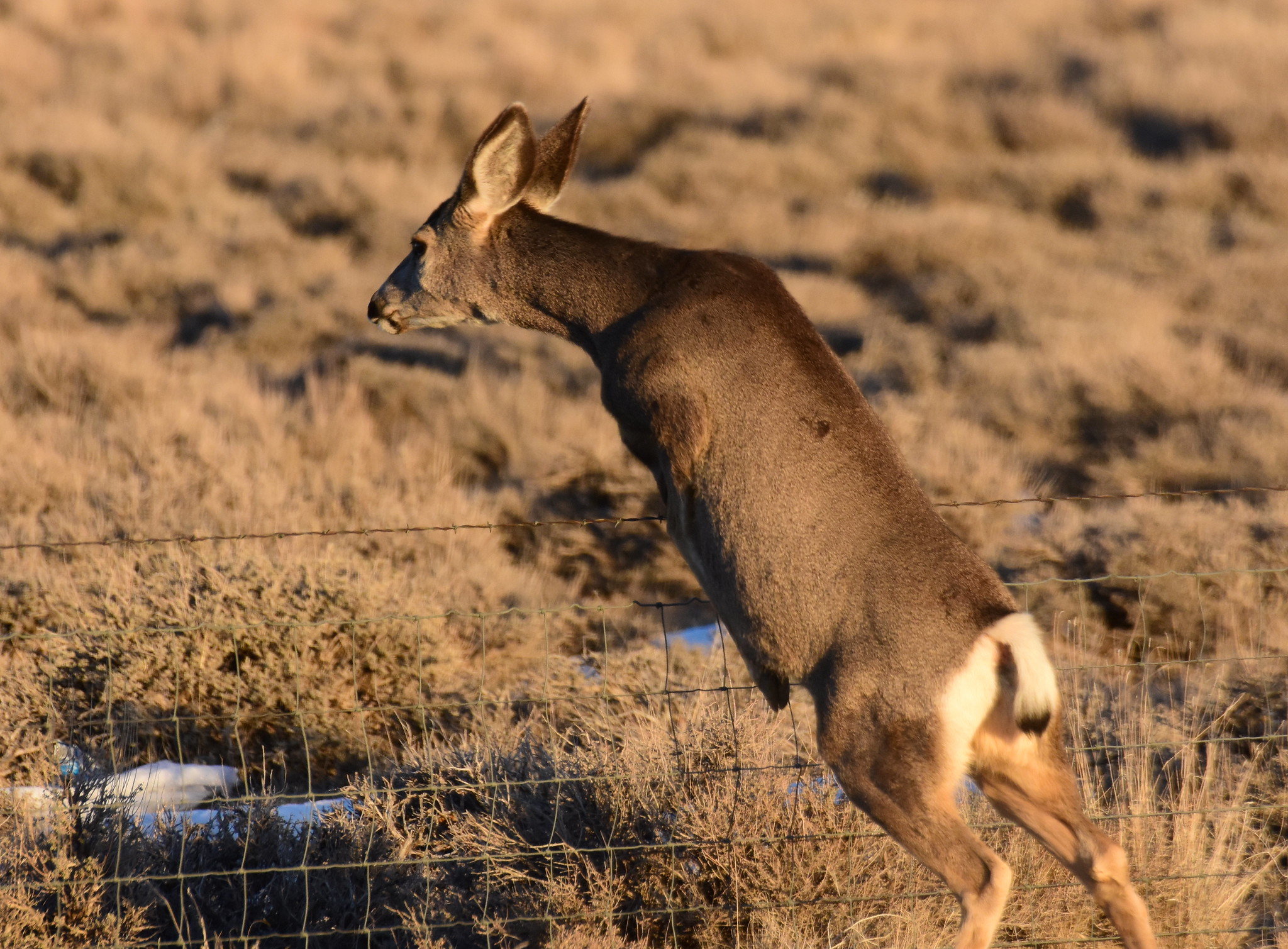
We can also lump energy development under this heading. Whether we’re talking about the installation of natural gas wells in Wyoming or building a wind farm in New Mexico, energy projects (“green” or otherwise) create problems for mule deer.
Solution: Fence Removal and Conversion
When it comes to making it simpler for mule deer to migrate, fence removal and rehabilitation is a top priority.
“The easier you can make it for deer to get from where they are to where they need to go, the better,” says Ian Tator, terrestrial habitat supervisor with Wyoming Game and Fish Department.
A shining example is the work that’s been done to remove or rehabilitate more than 691 miles of fencing in the Red Desert to Hoback corridor, which is the world’s longest mule deer migration route.
To make fencing wildlife friendly, the goal is to make the top wire as low as possible (38 to 42 inches above the ground) while making the bottom wire as high as possible (16 inches off the ground is okay; 18 is better). Such fences are still able to contain livestock.
Solution: Reducing Collisions with Vehicles
In Wyoming, about 4 percent of mule deer are killed by motor vehicle collisions every year—a death toll that dwarfs what predators kill, reports Andrew McKean, Outdoor Life’s hunting and conservation editor. And that’s just a small slice of the greater roadkill pie across the U.S. Each year, approximately 2 million elk, deer, bear, rabbits, raccoons, and other critters meet their demise along America’s highways and country roads.
The installation of “wildlife accommodation” fencing and the construction of overpasses and underpasses that create a safe way over or under highways for wildlife are some of the steps being taken to reduce the death toll.
A key section in McKean’s report states: As part of last December’s federal infrastructure law, Congress dedicated $350 million over five years to the Wildlife Crossings Pilot Program, which aims to incentivize states, municipalities, tribes, and NGOs to submit plans to reduce wildlife mortality in the spots with the biggest roadkill problems. That’s in addition to the $350 billion the law appropriated for highway projects over the next five years.
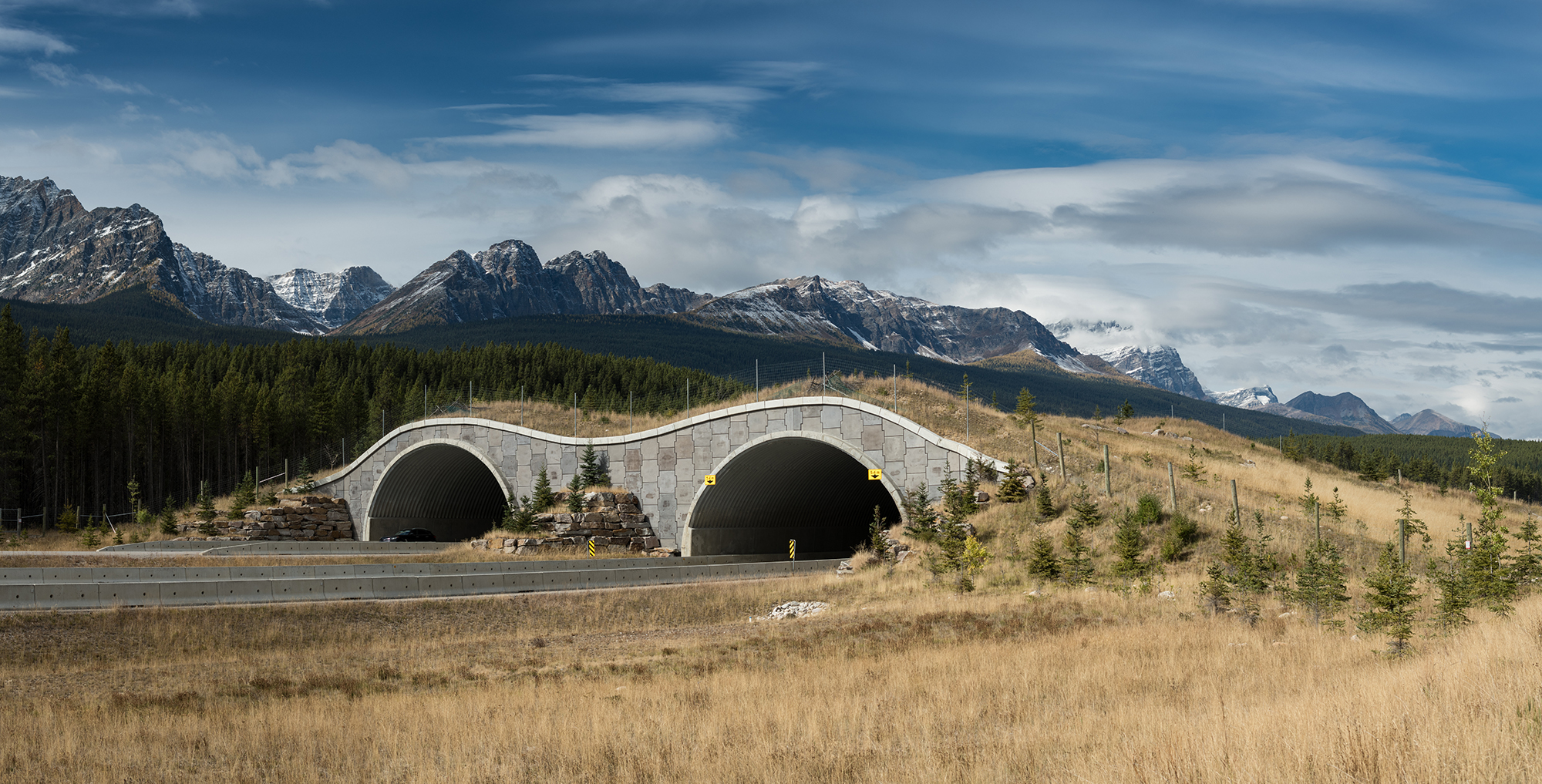
Solution: Conservation Easements
Conservation easements have been one of the most effective tools for mule deer conservation, as it accomplishes the dual goals of keeping the landscape intact while guaranteeing public access. Typically, a rancher or other landowner will work with their state to purchase rights to a significant portion of their land, rather than have the property broken into smaller segments and sold off piecemeal.
This is a win-win in that it provides landowners with much-needed cash to keep their operation going, while protecting and conserving critical habitat—particularly when the next generation in the family isn’t interested in ranching or farming.
In Montana, unfortunately, this program is under fire from Gov. Gianforte’s administration, which has reshaped the Montana Land Board with far-right politicians who seem hostile toward the program’s ability to secure easements in perpetuity.
Solution: Consulting with Developers
States in the intermountain West have traditionally been very pro-development, whether talking about subdivisions or energy exploration. That is unlikely to change. But in Wyoming—where that proclivity is chiseled into the state’s bedrock—there’s an effort to consult with developers about the impact that their proposals will have on mule deer and other wildlife.
Though these efforts don’t have the force of law behind them and are purely advisory in nature, such discussions arm developers with information to lessen negative outcomes from their projects.

Shrubs, Trees, and Grasses
It’ll come as no shock, I’m sure, to learn that the plants that mule deer eat, sleep under, and walk around are pretty important to their survival. Sage, aspen, and bitterbrush are all critical for mule deer, while invasive grasses and conifer encroachment are challenges that have to be countered.
Problem: Unproductive Shrub Communities
When shrubs hit a certain age—depending on the specific plant—their nutritional quality drops which makes them less beneficial for mule deer and other wildlife. Fire suppression (discussed below) contributes to this issue.
Solution: Sagebrush Revitalization
A lot of on-the-ground conservation efforts involve shrub mowing and mastication—basically running vegetation through machines that chews it into small pieces and spits it out. Towing mowers behind large tractors is costly and time-consuming, but create precise mosaics of sagebrush that is ideal for mule deer and sage grouse.
Problem: Invasive Annual Grasses
The issue with noxious grasses—cheat grass, Ventenata, medusa head, and others—is that they convert habitat that’s good for mule deer into habitat that isn’t. Annual grasses reproduce by seed each year and are unwittingly spread by people via roads and trails, as well as natural means, like the wind.
Solution: Rejuvra
This is one of the more exciting developments in mule deer conservation in recent years. Rejuvra is an herbicide typically broadcast by helicopter that prevents invasive annual grasses from growing for several years.
It is relatively new—barely five years old—and widespread use has only started in the last couple years, but it is already yielding good results. In Wyoming alone more than 100,000 acres of mule deer habitat have been sprayed with it.
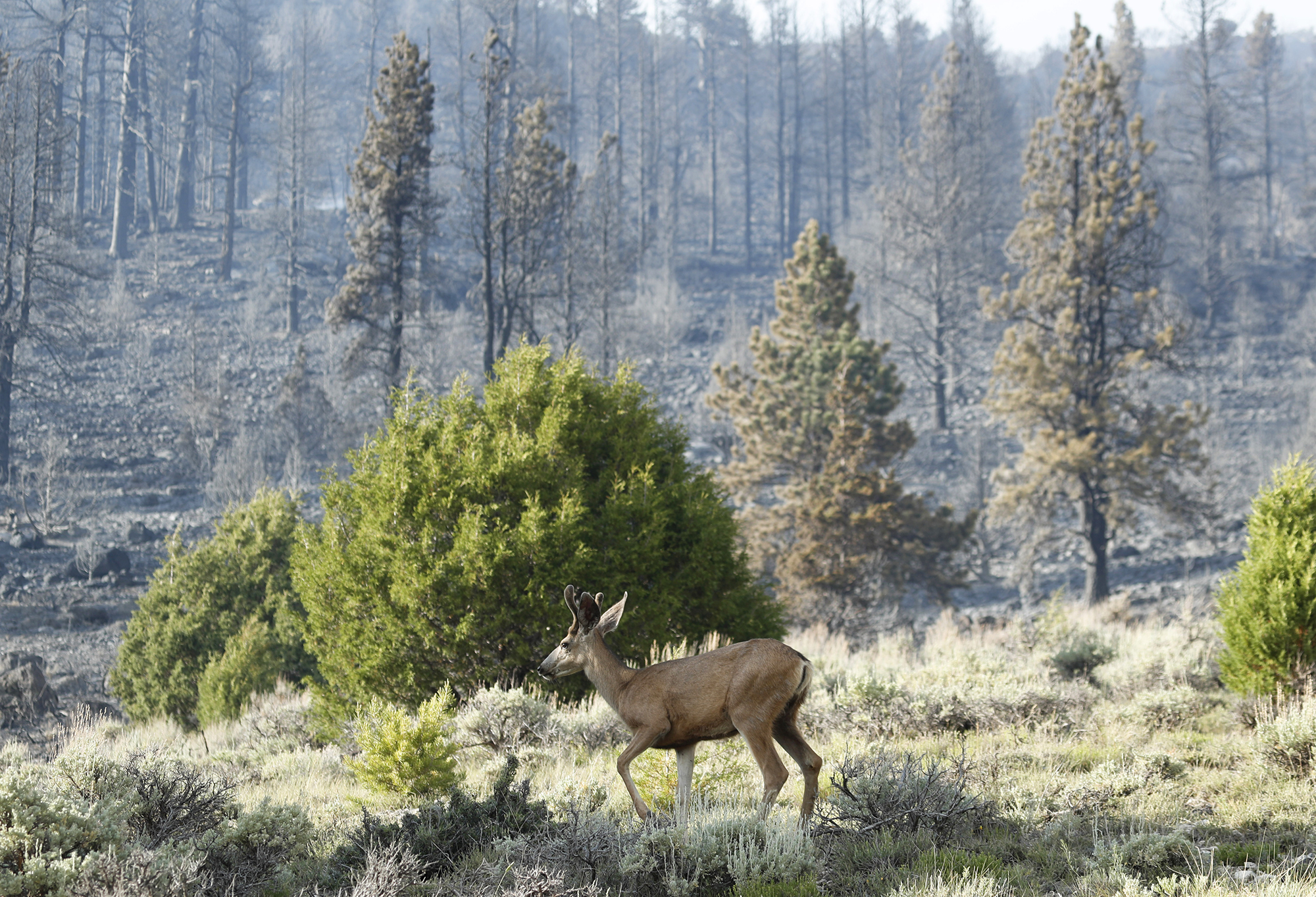
Problem: Wildfire—Not Enough and Too Much
Decades of fire suppression combined with persistent drought across much of the Southwest have created a major headache for wildlife managers and conservationists.
We’ve painted ourselves into a corner by allowing the amount of fuel to grow to the point where we risk destroying the soil’s ability to nurture plant life. Now, when fires do occur, they burn so hot that they kill the organic matter in the ground.
Fire suppression also degrades the environment by breaking the natural burn cycle that allows plants to rejuvenate and sprout young, nutritious browse. Aspen is a prime example of a plant that sustains deer and elk and that requires fire to stay vital and healthy.
Solution: Controlled Burns
In this case, we know what the answer is: controlled (aka prescriptive) burns, coupled with efforts to thin timber and reduce excess fuel in the landscape.
But executing controlled burns on the necessary scale is frustratingly difficult. The degree of coordination required to pull one off is formidable. Everyone from local volunteer fire departments, landowners, and town officials up through the ranks of federal and state game and environmental officials needs to be on board. And, of course, the weather needs to cooperate.
Compounding the problem is the need for someone to actually give the okay—and be accountable for what happens. The upshot is that burning is a powerful, useful, and necessary tool, but deploying it on the scale needed is an uphill battle.
Nowhere is fire more useful than in the effort to improve aspen habitat.
“Aspen needs disturbance to thrive and fire is the best tool for that,” says Steve Belinda, chief conservation officer for the MDF. “Any given year we’re doing thousands of acres of aspen work. But because of the administrative hurdles required to burn, we’re generally doing a lot of chainsaw work to cut down conifers and reduce the competition aspens face. In some instances, we can use the conifers as fuel for ground burns to stimulate suckers, meaning new aspen growth.”
The $60 million funding agreement the MDF signed last week with the U.S. Forest Service aims to cut through much of that bureaucratic tangle and expedite forest thinning, prescribed burning, and vegetation treatments that will not only help reduce the risk of catastrophic wildfire in the West but also improve mule deer habitat.
Problem: Conifers Run Wild
As Belinda alluded to above, when trees like Douglas fir, piñon pine, and junipers are allowed to grow unchecked, they shade out aspen, mountain mahogany, and other shrubs, degrading mule deer habitat.
Solution: Chaining and Prescribed Burns
While burning is the ideal way to address conifer encroachment, a lot of the work involves cutting them with chainsaws or using a technique called “chaining,” where heavy-duty chains (think of the kind use to anchor an aircraft carrier) are strung between large tractors and dragged over stands of conifers to knock them down.
“In Arizona we go through a lot of piñon-juniper, grinding it up,” says Bob Jacobs, who sits on the board of directors at the Mule Deer Foundation and who owns a fire protection company in Flagstaff. “Even though piñon-juniper is native, it is out of proportion to what it should be. Fire suppression, grazing, and drought have spurred the spreading of PJ across the landscape. It sucks up water and shades the ground from light, not allowing other plants to grow.”
Solution: Forest Thinning
Not all mule deer live in arid regions. Sitka blacktails call the rainforests of coastal Alaska home and one of the issues they face is the loss of habitat due to poor logging practices.
“Prince of Wales Island had 60 years of clear-cutting that created a lot of [short term] habitat,” Belinda says. “All that forest is reaching second growth and stem exclusion, which means all the sunlight is being eaten up by the crown and no light is getting to the forest floor.”
That’s in conjunction with dense grass in the undergrowth that makes the terrain not very functional for animals, Belinda says. “It’s hard to move through and doesn’t have good groceries.”
Because these elusive deer are difficult to track and count, research is needed to figure out the extent of this issue and recommend forestry practices to thin the maturing second growth and ensure the adequate fringe areas along the beaches that blacktail rely on for food and cover.

Human Impact
It’s the classic break-up line: It’s not you, it’s me. In this case, it is us. In the complex relationship between people—hunters and non-hunters—and mule deer, we are the problem.
In the case of hunters, the issue is that mule deer are the object of too much attention and desire, making it difficult for wildlife managers to balance hunting opportunity while maintaining populations of mature males with trophy potential in the context of overall herd health. When it comes to non-hunters, mule deer suffer from indifference and neglect (also proximity, as mentioned in the development section above).
Solution: Dealing With Hunter Expectation
Hunters want opportunity. They also want the chance to take a mature animal. Some hunters value meat and time afield over antlers while others are willing to eat a tag as long as an encounter with a heavy-horned brute is possible.
This is one of those dynamics that doesn’t have a clean-cut solution. You’re never going to make every hunter happy, but that doesn’t mean wildlife managers shouldn’t try.
Communication is key. Prior to every hunting season in Wyoming, for instance, Game and Fish officials meet with the public to discuss changes to the regulations and management proposals.
Wyoming also surveys hunters after the season and folds that data into its Job Completion Reports that offer a detailed look at big-game harvests, management goals, and hunter satisfaction. By engaging with the hunting public in such a way, Wyoming mitigates some of the misunderstandings (and conspiracy-oriented misinformation) that can take root otherwise.
“There is no silver bullet,” says Tator of WGFD. “But it goes back to staying connected with the constituents and understanding what they desire by talking with them and conducting surveys. We’re always trying to answer the question: What would you like from us?”
In addition, it seems there are more people across the West who are interested in mule deer and mule deer hunting than ever. While this can lead to more engagement with (and funding for) conserving mule deer habitat, it is an added strain on the resource.
Solution: Dealing with Non-Consumptive Outdoor Recreationalists
One huge issue for mule deer conservation efforts is trying to convince non-hunters that their hobbies—whether mountain biking, hiking, backcountry camping, off-roading, or birding—have negative impacts on deer and other wildlife.
“A lot of these users expect access 365 days a year and don’t understand disturbance ecology,” says Steve Belinda, MDF’s conservation chief.
As a prime example, Belinda points to the desire among mountain bikers to establish and ride loop trials in the wilderness.
“Bikers don’t like to follow a trail back, they much prefer going in a large loop,” Belinda says. “Animals don’t like to be contained in [such] a loop and will move off, which burns fat or prevents them from putting on fat. That affects birth rates and birth weights, which are critical for fawn survival.”
Some state agencies are attempting to limit trail use and shut them down for portions of the year but face stiff resistance from these recreationalists.
“These folks want to be out there all the time and don’t care about deer and elk or pronghorn or sage grouse,” Belinda says.
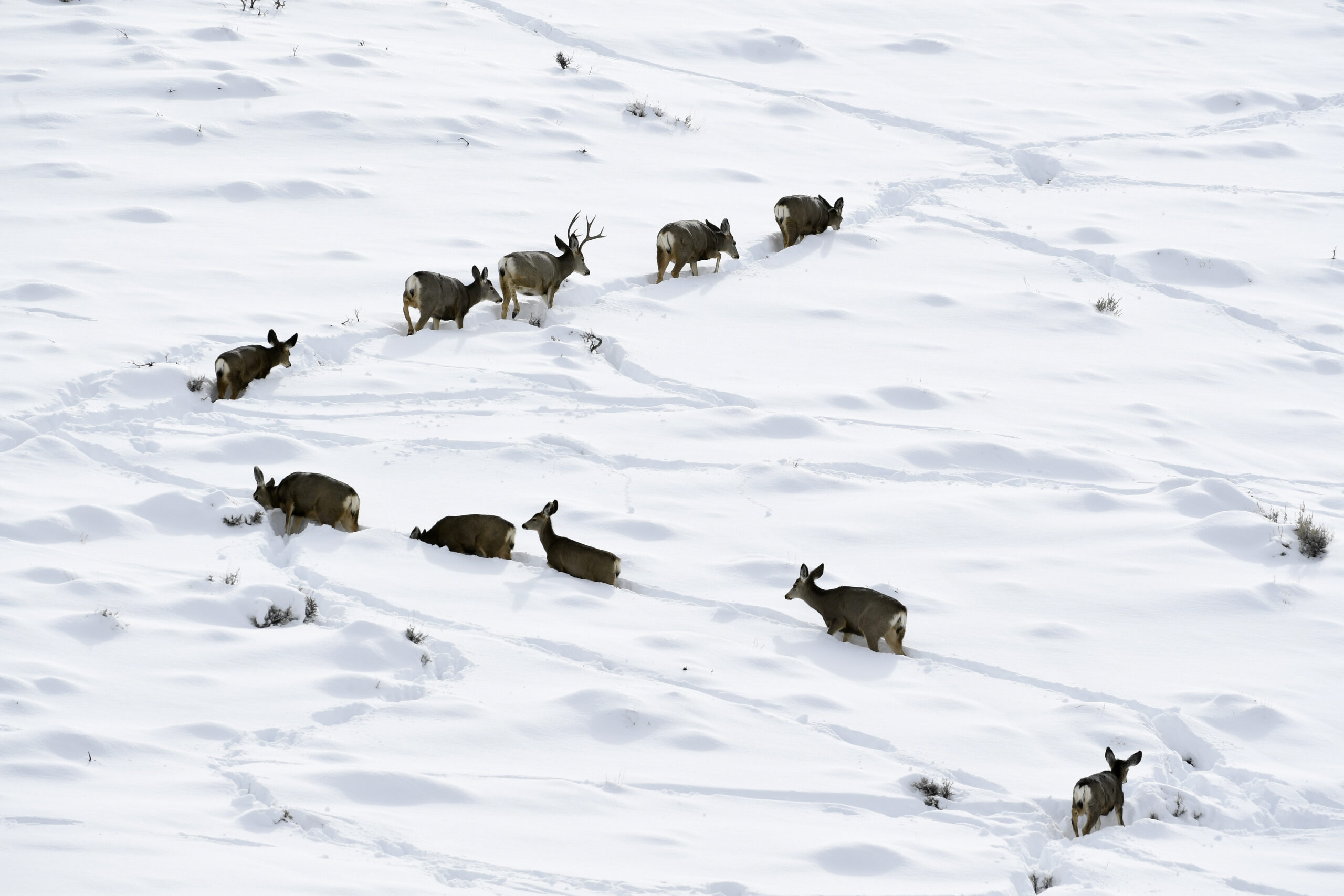
Another goal to lessen these impacts is by having recreationalists pay for access or otherwise contribute money for conservation. But just as everyone wants to be a gangster until it’s time to do gangster stuff, the majority of these people—who would probably describe themselves as conservationists—have balked when any type of user fees or other costs have been proposed.
Utah, for instance, recently closed all shed and horn hunting until May to lessen the disruptive impact those activities can have on mule deer and elk in light of this year’s harsh winter.
These issues will only become more acute as places like Colorado, Montana, and Idaho continue to experience significant influxes of new residents, many of whom will add pressure to an already stressed resource.
Climate Change
The earth is getting hotter, droughts—that we used to think of as temporary phenomena—have become more frequent and intense, and we seem to be subject to an increased tempo of extreme weather.
Naturally, this has made life tougher on mule deer and other wildlife. (Though mule deer in Canada are on the increase in part because of these shifts.) These changes in the climate don’t have isolated impacts. They affect many of the factors we’ve already touched on, such as wildfires, conifer encroachment, habitat loss, and the movement of people from drier areas—such as Texas and California—to the Rocky Mountain West.
Solution: Coping with Relentless Drought
Of all the problems caused by climate change with respect to mule deer (and there are too many to fully articulate here) the one that’s most straightforward to address is water.
We’ve been in the midst of an historic drought for decades now and that’s spurred efforts to keep adequate moisture in the landscape. Curiously, the issue isn’t just a lack of precipitation but also inconsistent rainfall where some storms do more harm than good.
“It appears the timing of when we receive moisture has become highly variable,” says Tator. “So even if we’re still getting 16 inches every year, say, it matters when it comes. We want early season moisture because we want it in the ground during growing season. And we want some amount of moisture to continue throughout the summer. But we’re seeing big breaks in time with no moisture and then you get a dump of four inches–that doesn’t translate to mule deer food.”
More than that, a harsh rain can wash away vegetation that was already struggling from lack of moisture and erode the ground in such a way that water is more prone to flowing quickly off the landscape.
Four of the most effective techniques to keep water around—to “rewet the sponge,” in the words of one biologist—are beaver dam analogs, Zeedyk structures, spring restoration, and cisterns that capture water and redistribute it over time.
Beaver dam analogs are fairly self-explanatory. They are manmade barriers that slow down and hold back water to create pools and other pockets of moisture. Zeedyk structures are similar. Sometimes called one-rock dams, they are relatively inexpensive and easy to install and are used to slow the flow of water in streams and creeks and mitigate erosion.
Even retaining a modest amount of water can have an outsized positive impact. An extra bit of moisture can make browse more nutritious, caloric, and digestible, giving mule deer better prospects and help does with their fawn survival rates.
“Zeedyk structures are meant to keep those areas from unraveling during big rain events,” Tator said. “They help stop deep cuts from occurring and make the areas more resilient.”
In the drier regions of the Southwest a priority has been to upgrade cisterns to increase their capacity. “We’re replacing 2,500-gallon tanks with 20,000-gallon tanks,” says Bob Jacobs. The tanks catch water and then pump it back into the environment, not only for the benefit of mule deer but to help the growing number of elk in some parts of the Southwest.
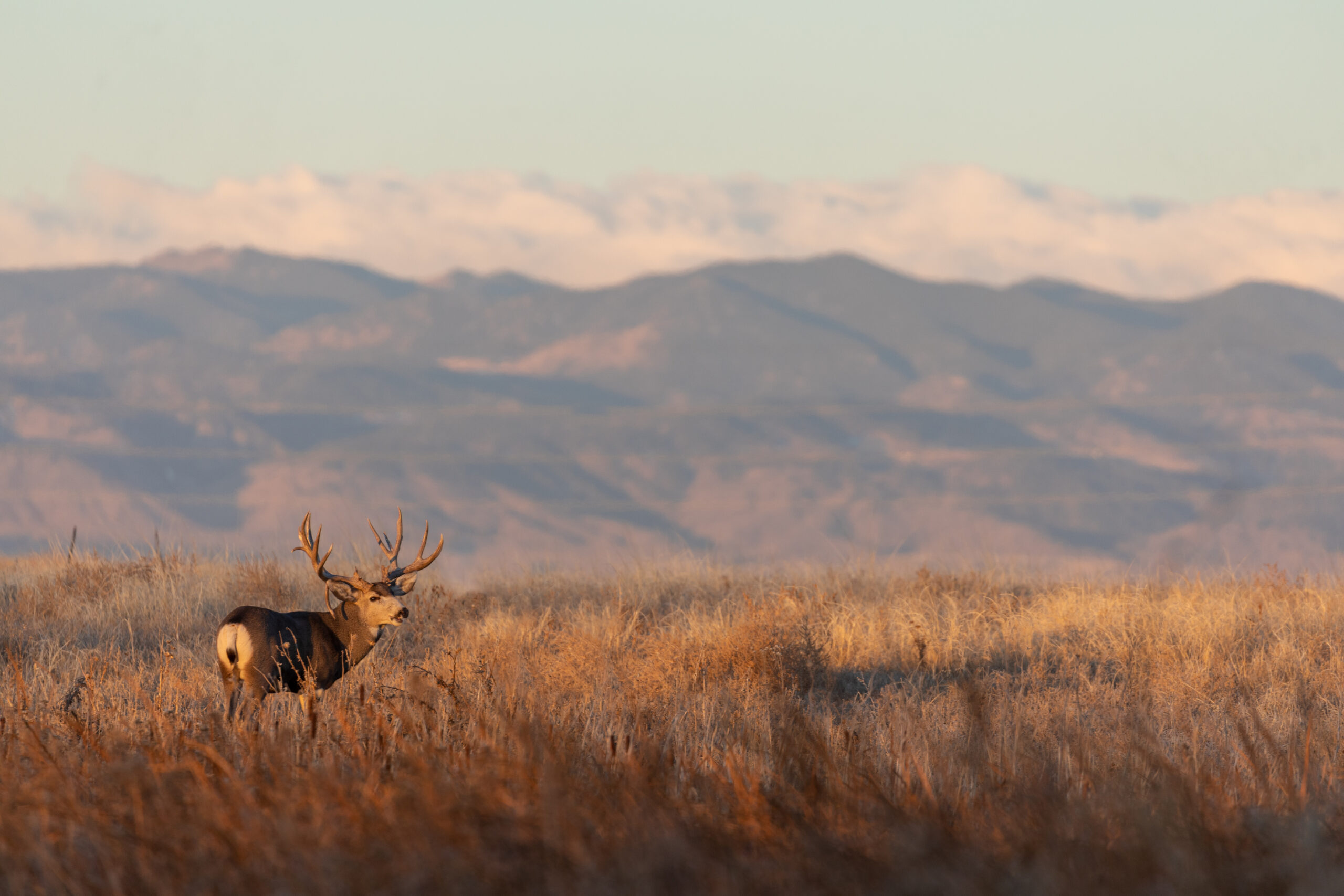
Chronic Wasting Disease
Of all the problems enumerated in this story, CWD might be the most intractable and dispiriting. Here are the facts as they stand today. CWD is spreading across the mule deer landscape. It is 100 percent fatal among infected elk, mule deer, and whitetails. The most vulnerable individuals are mature bucks. These mature bucks are the most significant spreaders of the disease. And CWD has no cure.
The Problem with CWD Is There’s No Solution
This leaves biologists and game officials with no palatable, let alone “good,” options to deal with the disease. On the one hand they can let the disease spread unchecked. This will hasten the introduction of CWD to as-yet uninfected populations and accelerate the percentage of deer infected in currently afflicted herds.
The long-term consequences of this approach are potentially catastrophic. Barring the emergence of some type of natural immunity—which we’ve yet to see occur in the decades of tracking the disease—it could mean the virtual disappearance of older age-class mule deer bucks. In this future, a 3 ½-year-old 140-point muley might be as good as it gets, because they won’t survive beyond that point to grow bigger.
Read Next: In the War Against CWD, Deer Breeders in Texas Are Being Cast as Both the Enemy and the Answer
High rates of infection can also cause herd numbers to decline, both from the fatal nature of the disease, but also from the increased difficulty for mule deer does to have enough fawns to replace adult deer succumbing to CWD.
Whitetails in the Midwest, which have much higher reproductive success, aren’t as vulnerable in this regard, but for Western mule deer, which already have a hard time of it, this could push them past a tipping point.
Some mule deer herds in Wyoming and Saskatchewan already have CWD infections rates of 60 to 70 percent in bucks. How those herds fare could give us a glimpse of the future prospects for the specie.
On the other hand, the other way to address the problem isn’t pretty either. It involves shooting most, if not all, deer in particularly hot CWD areas. This approach is favored by many biologists as it seems to be the best way to slow the spread of the disease to uninfected herds.
Maybe it is the least bad option, but the rationale smacks of the Vietnam War strategy of burning a village down in order to save it. Even among wildlife professionals, this “solution” leaves a bad taste in their mouths, while most hunters viscerally recoil against the idea.
The concept is a hard one to swallow. Basically, it says that the area you like to hunt now, which has good (or reasonable) trophy quality should be sacrificed because at some unknown point down the road—15 years? Longer?—there won’t be any trophy bucks, or the potential for trophy bucks, at all. It’s a tough sell.
Predators
CWD might not have a solution, but in most hunters’ eyes, there’s a straightforward fix to dealing with predators that key on mule deer: remove more of them from the landscape through hunting and trapping. Depending on geography and time of year, black bears, coyotes, wolves, and mountain lions all prey on mule deer—but the actual impact of their predation is often poorly understood and, in many cases, overstated by the general hunting public.
“Generally, predators are part of the system and when they are managed and balanced with prey species, the animals they take don’t have a big impact on mule deer numbers,” Tator says. “But when populations are already suppressed through habitat issues, bad winters and other factors—adding predation on top of that creates the potential for predators to have a negative effect.”
Solution: Predator Hunting
If you want to do something to protect mule deer from predators, go hunt black bear this spring. While you’re at it, kill some coyotes in April around mule deer fawning grounds. Those two activities might actually save some mule deer.
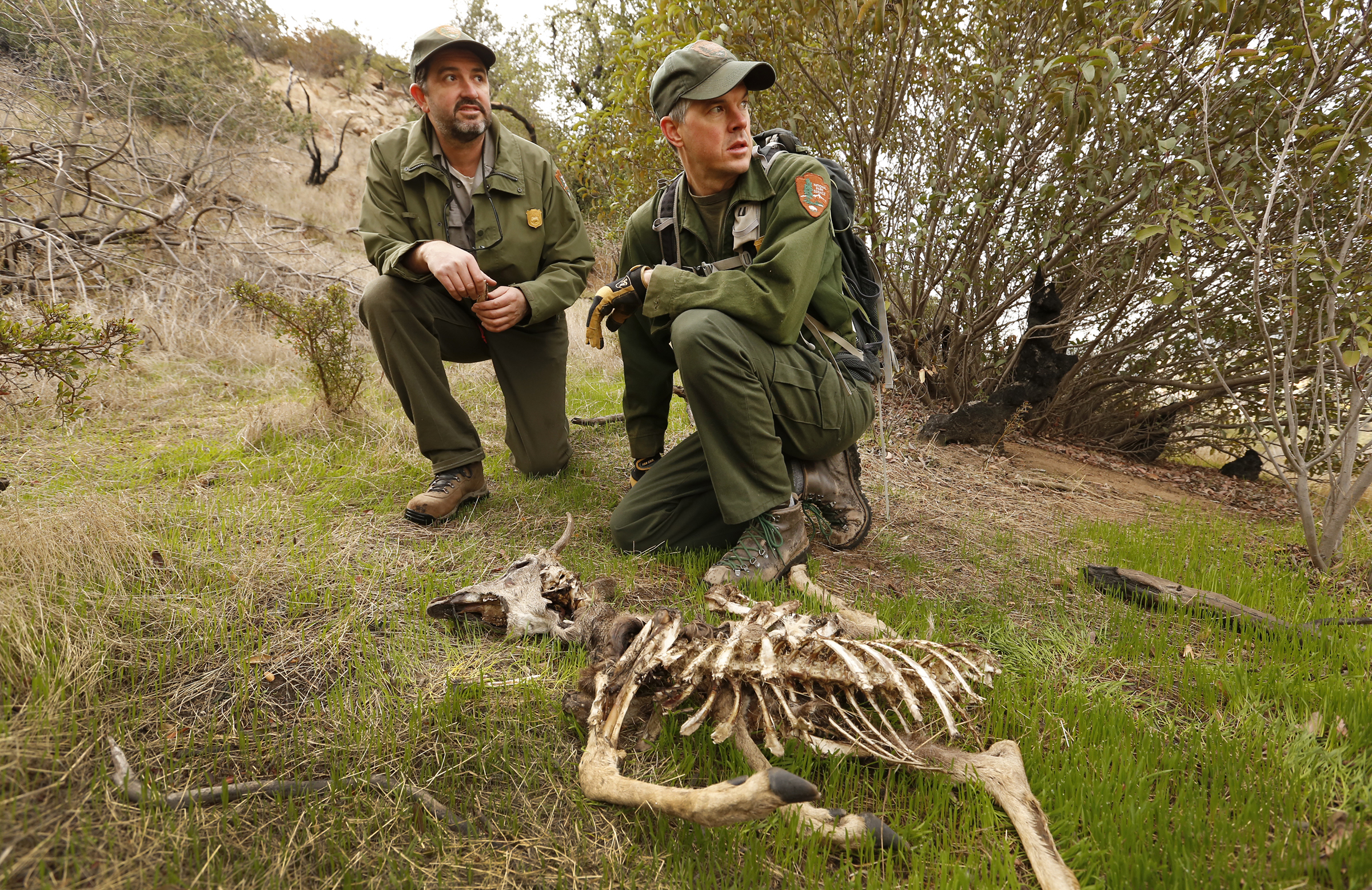
A common refrain among hunters is that adult mountain lions eat a deer a week, so that by killing one mountain lion you’re saving 52 deer a year. The truth is more complex, and difficult to quantify than that.
“Lions by their nature are secretive. They are hard to count. And there’s a small, specialized group who are good at killing them,” Tator says.
In light of the strict quotas placed on mountain lion hunts, the focus on just taking large males (which some studies indicate simply encourages more lions to move into the landscape), the complex interplay between mountain lions and other predators, and the absence of reliable numbers, it is a stretch to draw conclusions about the benefits of mountain lion hunting on mule deer populations.
That said, in certain circumstances, increasing mountain lion hunting opportunities has been shown to help mule deer.
Bob Jacobs pointed to an example of a hunting unit in Utah where mule deer had high fat content—meaning they were eating well and relatively unstressed. When mountain lion hunting quotas were increased in that area, mule deer numbers improved. In contrast, he said there was a case where increasing the lion quota on more stressed deer with lower body fat didn’t yield the same benefit. That seems counterintuitive, but it illustrates the complexity of managing predators for mule deer.
Solution: Cause-of-Death Studies
Utah has led the way in placing collars on mule deer to gather all kinds of data, including tracking causes of deer mortality. Over the last eight years, the state has captured and collared some 5,000 deer. During this time, Utah has been able to gather about 1,500 collars from deer that have died to analyze the data.
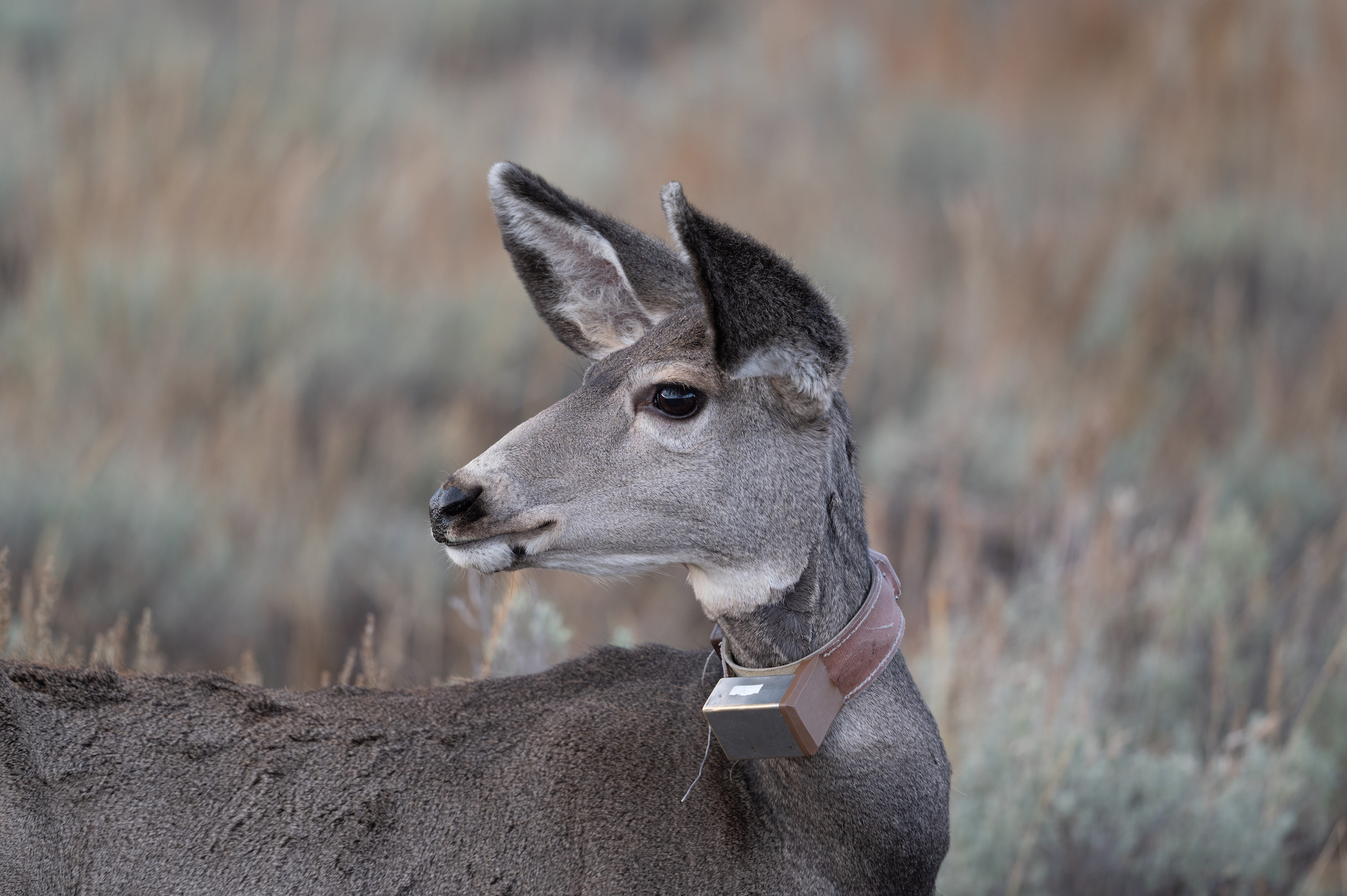
Wyoming is following suit and recently collared 1,000 mule deer. Those 1,000 deer are spread across five major population groups of more than 200 individuals each, and two of those groups, or 400 deer total, are being specifically investigated to study cause of death, Tator says.
That five-year Wyoming study, along with the ongoing efforts in Utah, will help unravel some of the mysteries regarding mule deer mortality. Whenever a collared deer dies, wildlife officials will collect the carcass to determine the cause, whether from predators, pick-up truck bumpers, disease, or marginal habitat.
Final Thoughts on Mule Deer in 2023
There’s no shortage of effort to help mule deer. But because the threats facing them are multifaceted, interrelated, and regionally specific there are no one-size-fits-all answers. If all politics are local, the answers to the woes besetting mule deer are even more so.
When Lewis and Clark wrote about “deer of the Mule kind” during their voyage of discovery—giving mule deer their name—they had no inkling what that “curious kind of deer” would come to mean to generations of conservationists and hunters.
So even though the challenges facing mule deer are steep—some seemingly insurmountable—it’s hard not to be hopeful when you consider the millions of dollars, thousands of volunteers, and hundreds of trained biologists and wildlife professionals who are in the mule deer’s corner, fighting on their behalf.
